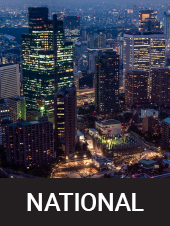A storm is brewing. A solar storm, that is.
It’s already been a banner year for northern lights viewing in Canada this year, but Mother Nature isn’t done yet. A strong solar storm is expected to hit Earth Tuesday night and potentially last until Thursday, which could light up the night sky with a brilliant aurora borealis this week.
The U.S.’s National Oceanic and Atmospheric Administration (NOAA), which tracks space weather events, is anticipating that the northern lights will be visible as far south as Oregon and the U.S. Midwest, putting Canada right in the path for a spectacular light show.
The peak of the solar storm is expected to come Tuesday night. NOAA is forecasting a “strong” G3 solar storm for Tuesday and “moderate” G2 storms on Wednesday and Thursday. The G-scale describes the strength of a solar storm, with G1 being the weakest and G5 being the most severe.
A map of how far south the northern lights can be observed given the severity of the solar storm.
National Oceanic and Atmospheric Administration
In order to see the northern lights, however, conditions need to be just right.
Breaking news from Canada and around the world
sent to your email, as it happens.

Get breaking National news
For news impacting Canada and around the world, sign up for breaking news alerts delivered directly to you when they happen.
“For best viewing, you should try to get away from the bright city lights and look to the north,” Global News meteorologist Anthony Farnell said in May, when a similar solar storm hit Earth and lit up the skies above Canada.

Too much light pollution from urban centres, or even the light from the moon, can overpower the northern lights and make them difficult to see. Thankfully, our current moon phase is a waning crescent, with less than 25 per cent of the moon illuminated through this week.
NOAA also recommends trying to view the aurora “within an hour or two of midnight,” or between 10 p.m. and 2 a.m. local time, when geomagnetic activity is highest.
Be sure to check your local weather forecast, as well, as you’ll need a clear sky to view the northern lights.
NOAA first issued a warning of an imminent solar storm on Monday after it observed elevated activity on the surface of the sun.
A number of solar flares and coronal mass ejections (CMEs) erupted off the sun and have been hurtling towards Earth since the weekend. The first of these CMEs arrived Monday night and triggered a minor G1 solar storm. Additional CMEs that followed are expected to arrive on Tuesday and Wednesday, with the “brunt of the activity” most likely coming on Tuesday.
Since NOAA’s first warning, solar activity has increased. At least four more CMEs are bound for Earth, prompting the NOAA to update its forecast, predicting solar storm conditions through Thursday.
Space Weather Canada is also predicting “stormy” conditions within the next 24 hours.
© 2024 Global News, a division of Corus Entertainment Inc.






